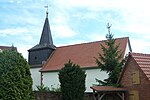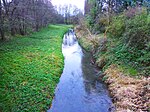Aue (Suhle)
Rivers of GermanyRivers of Lower SaxonyTributaries of the Rhume
The Aue (German: Aue or Aue Bach) is a meandering stream in Lower Saxony, Germany. The Aue source is near Waake. It enters the Seeburger See near Seeburg and drains it at Bernshausen. A mere creek, it is not navigable. It is a left (west) tributary of the Suhle in Germershausen, part of Rollshausen. The elevation at the mouth is about 157 m asl. There are a number of small neolithic Linear Pottery culture settlements along its banks.
Excerpt from the Wikipedia article Aue (Suhle) (License: CC BY-SA 3.0, Authors).Aue (Suhle)
Klosterstraße, Samtgemeinde Gieboldehausen
Geographical coordinates (GPS) Address Nearby Places Show on map
Geographical coordinates (GPS)
| Latitude | Longitude |
|---|---|
| N 51.5662 ° | E 10.1931 ° |
Address
Flüchtlingsunterkunft
Klosterstraße 28
37434 Samtgemeinde Gieboldehausen (Germershausen)
Lower Saxony, Germany
Open on Google Maps









